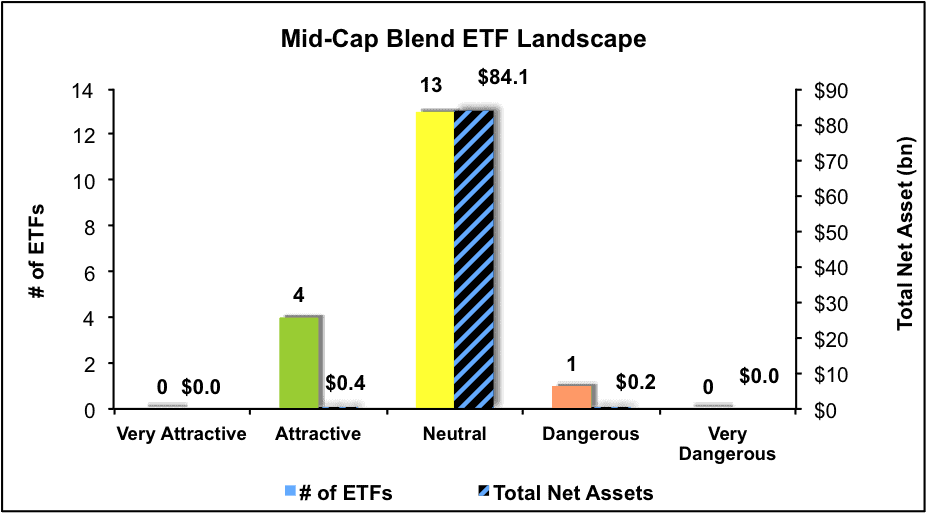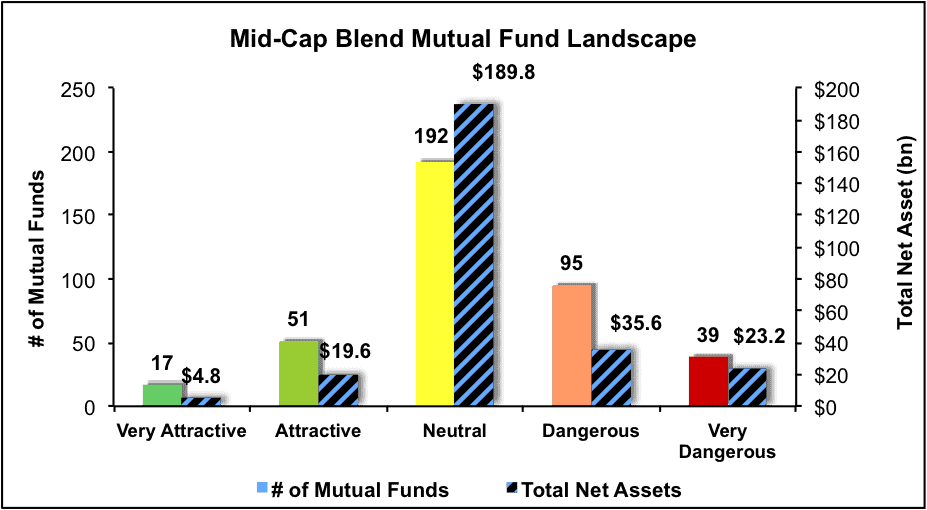The Mid Cap Blend style ranks seventh out of the twelve fund styles as detailed in our 4Q16 Style Ratings for ETFs and Mutual Funds report. Last quarter, the Mid Cap Blend style ranked seventh as well. It gets our Neutral rating, which is based on an aggregation of ratings of 18 ETFs and 394 mutual funds in the Mid Cap Blend style as of November 4, 2016. See a recap of our 3Q16 Style Ratings here.
Figures 1 and 2 show the five best and worst rated ETFs and mutual funds in the style. Not all Mid Cap Blend style ETFs and mutual funds are created the same. The number of holdings varies widely (from 22 to 3,213). This variation creates drastically different investment implications and, therefore, ratings.
Investors seeking exposure to the Mid Cap Blend style should buy one of the Attractive-or-better rated ETFs or mutual funds from Figures 1 and 2.
Figure 1: ETFs with the Best & Worst Ratings – Top 5
* Best ETFs exclude ETFs with TNAs less than $100 million for inadequate liquidity.
Sources: New Constructs, LLC and company filings
Absolute Shares WBI Tactical SMS (WBIA, WBID, WBIB) is excluded from Figure 1 because its total net assets (TNA) are below $100 million and do not meet our liquidity minimums.
Figure 2: Mutual Funds with the Best & Worst Ratings – Top 5
* Best mutual funds exclude funds with TNAs less than $100 million for inadequate liquidity.
Sources: New Constructs, LLC and company filings
Ultimus Managers Trust Barrow Value Opportunity Fund (BALIX), Boston Trust Walden Mid Cap Fund (WAMFX), and Boston Trust Mid Cap Fund (BTMFX) are excluded from Figure 2 because their total net assets (TNA) are below $100 million and do not meet our liquidity minimums.
ProShares S&P MidCap 400 Dividend (REGL) is the top-rated Mid Cap Blend ETF and Invesco Mid Cap Core Equity Fund (GTAFX) is the top-rated Mid Cap Blend mutual fund. REGL earns an Attractive rating and GTAFX earns a Very Attractive rating.
Guggenheim Raymond James Equity ETF (RYJ) is the worst rated Mid Cap Blend ETF and Quaker Mid Cap Value fund (QMCVX) is the worst rated Mid Cap Blend mutual fund. RYJ earns a Dangerous rating and QMCVX earns a Very Dangerous rating.
The Progressive Corp (PGR: $32/share) is one of our favorite stocks held by GTAFX and earns an Attractive rating. Since 2001, PGR has grown after-tax profit (NOPAT) by 8% compounded annually. The company has improved its return on invested capital (ROIC) from 13% in 2001 to a top-quintile 15% over the trailing twelve months (TTM). With the exception of 2008, the company has earned a double digit ROIC in every year since 2001. Despite the strong fundamentals, PGR remains undervalued. At its current price of $32/share, PGR has a price-to-economic book value (PEBV) ratio of 1.2. This ratio means the market expects PGR’s NOPAT to grow by only 20% over the remaining life of the firm. If PGR can continue growing NOPAT by just 8% compounded annually for the next decade, the stock is worth $58/share today – an 81% upside.
CoreLogic Inc. (CLGX: $42/share) is one of our least favorite stocks held by Mid-Cap Blend funds, and earns a Very Dangerous rating. Over the past decade, CoreLogic’s NOPAT has declined by 14% compounded annually. The company’s ROIC has fallen from 14% in 2005 to a bottom-quintile 4% TTM. Despite the deteriorating fundamentals, CLGX remains priced for significant profit growth. To justify its current price of $42/share, CLGX must grow NOPAT by 11% compounded annually for the next 11 years. This expectation seems overly optimistic given CLGX’s recent profit struggles.
Figures 3 and 4 show the rating landscape of all Mid Cap Blend ETFs and mutual funds.
Figure 3: Separating the Best ETFs From the Worst Funds
Sources: New Constructs, LLC and company filings
Figure 4: Separating the Best Mutual Funds From the Worst Funds
Sources: New Constructs, LLC and company filings
This article originally published here on November 4, 2016.
Disclosure: David Trainer, Kyle Guske and Kyle Martone receive no compensation to write about any specific stock, style, or theme.



